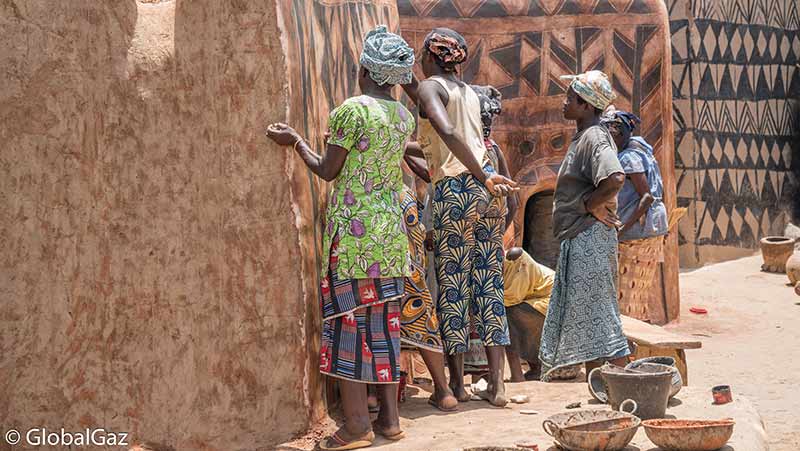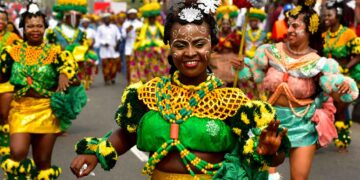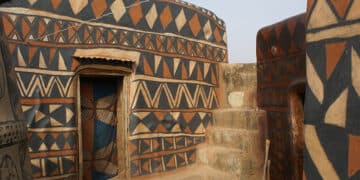Much about a people can also be gleaned from their architecture. In this article, we explore the lovely African architectural style found in the Tiébélé Burkinabé village.
When it came to buildings, all I knew were two kinds—bungalows and story buildings. But photography opened my eyes to more and that is how my burgeoning interest in African architecture began and led me to the painted houses of the Tiébélé Burkinabé. I have come to know and understand architecture as an art. The draw for me is the structure, patterns, and designs.
Where is the Tiébélé Burkinabé Village?
The African architectural style and painting of the houses in the Tiébélé Burkinabé Village is the heritage of the Kassena people, who originally came from Loumbila, close to Ouagagoudou, in the 15th century. They are one of the oldest ethnic groups in Africa. Sadly, the Kassena people who had familial ties with the greater Gurunsi people were historically divided along colonial governments of the French and British administrative systems, with some Kassenas living in Burkina Faso and some in Ghana.









Photo credit: Global Gaz
Construction of the Painted Houses of the Tiébélé Burkinabé Village
The Tiébélé houses are built with mud, straw, sticks, and clay. This takes me back to fond childhood memories, when we used mud and clay to make miniature stoves, pots, plates, and spoons whenever we wanted to take playing “mummy and daddy” to the next level. Playtime was a full production with directors, actors, costumes, and props and it was a lot of chaotic fun. Makes me wonder, what kind of fun kids nowadays claim to have.
The Tiébélé houses are known as sukhala, and traditionally, they are built by men during the dry season, which lasts from November to March. In some cases, mud and clay may be mixed together to form a type of plaster.
The roofs of the Tiébélé houses are usually made of straw, while the walls are built with mud and clay. The thick earthen walls also provide insulation from both heat and cold.
Sticks are used to form the frame of the buildings.
https://www.instagram.com/p/B_95iL8gTkE/?utm_source=ig_web_copy_link
The Significance of the Architectural Style of Tiebele Painted Houses
The designs and colors used to paint the walls of Tiébélé houses are symbolic of the people’s culture and beliefs. Prominent colors are black, which represents night and the spirit world; white, which symbolizes purity, and red which stands for bravery.
Women are the ones who carry out the painting of the motifs and patterns and the knowledge is often passed down from generation to generation. They reflect the Kassena people’s spiritual beliefs, as well as their view of the world.
Tiébélé house architecture is also symbolic of the people’s connection to the natural environment and their animist beliefs. The use of natural materials like mud, clay, and straw, reflects the Kassena people’s close relationship with the land and their deep respect for mother nature. The decorative motifs on the walls of the houses, which incorporate images of plants, animals, and other elements of the natural world, further emphasize this connection.
https://www.instagram.com/p/CRE7EuDrwLM/?utm_source=ig_web_copy_link
Tiébélé houses also confer social and cultural identity. Traditionally, families settle in square houses, bachelors have round houses and the elders have eight-shaped houses. The houses have one low and round front door with a low wall surrounding it to keep out wild animals and enemies alike.
The Relationship Between the Tiebele Painted Houses and Uli Art
On closer inspection of the images of the Tiébélé houses, I was reminded of Uli, also known as Uri, which is a cultural form of body and mural art practiced by Igbo women in Southeastern Nigeria. My younger sister chose a topic centered around Uli as her final project at the university and I helped her to edit her essay which was how I learned about it. She made her own motifs on fabrics with colorful dyes. The motifs had symbolic meanings and it was remarkable. I was so proud of her.
Although there are significant differences between Tiébélé house painting and Uli art, they both share similarities which involve the use of geometric patterns and motifs to create significant designs. Both are deeply rooted in cultural traditions and serve as an important means of communication and expression.

Is Tiébélé Burkinabé Village a UNESCO Heritage Site?
In 2012, the Burkinabe government submitted a proposal to make the Painted Houses of Tiébélé a UNESCO World Heritage site, but it has yet to be officially recognized. The UNESCO World Heritage Centre does not disclose the reasons for the non-inscription of a particular site. It can be considered that Tiébélé house painting has not met one or more of the criteria and requirements that qualifies it to be approved as a UNESCO Heritage site.
The painted houses of Tiébélé Burkinabé attract tourists from far and wide that love and appreciate traditional arts, and are unlike other mud houses across West Africa.
REFERENCES
Alache: Uli Art, The Pursuit of Beauty
Britannica: African Architecture
Global Gaz: Tiebele Painted Houses
Infinite Dictionary: Pattern and Decoration: The Mud Structures of Tiébélé
Raluca Besliu: Tiebele: the Burkinabe village painted with 15th-century symbols
Safari Junkie: Tiebele – Probably the Most Beautiful Village in Burkina Faso!
































